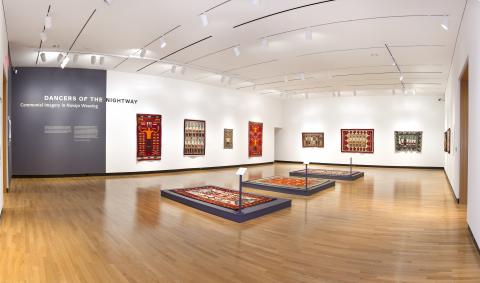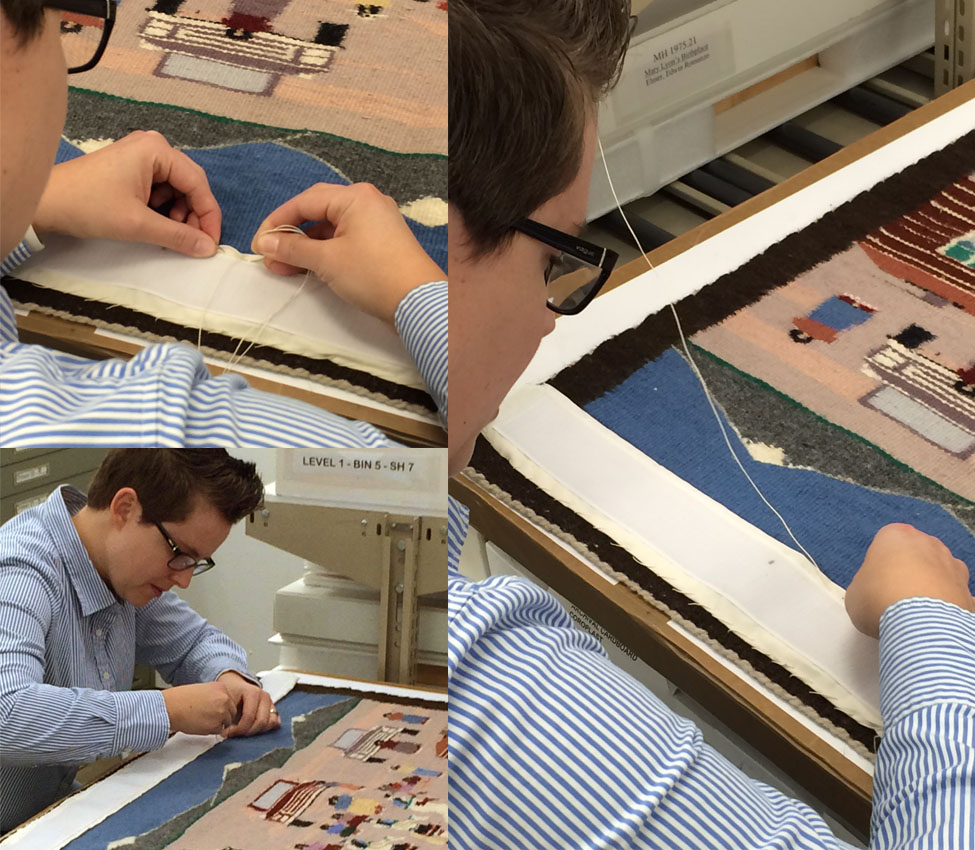Textile Tactics
Museum Preparator Jacqueline Finnegan reflects on the labor-intensive process of preparing textiles for exhibition. Thanks to her meticulous use of needle, thread, and Velcro®, the textiles in the current exhibition, Dancers of the Nightway: Ceremonial Themes in Navajo Weaving, seem to hover off the wall.
Textile Tactics
When visitors walk through the entrance to the Weissman Gallery to view MHCAM’s newest exhibition, Dancers of the Nightway: Ceremonial Imagery in Navajo Weaving, they will be entranced by the myriad colors throughout the textiles on display. Of course, my favorite part of this exhibition isn’t just the objects, but the way in which they are installed. If I’ve done my job successfully, visitors will hardly notice how each weaving seems to levitate from the floor and gently hover off the wall. A little Velcro® makes for a great installation method for sturdy wool textiles.

Installation view, Dancers of the Nightway: Ceremonial Themes in Navajo Weaving, Mount Holyoke College Art Museum, January 19-May 29, 2016.
It’s not every day that I get to work with beautiful textiles such as those from the collection of exhibition curators Rebecca and Jean-Paul Valette. In preparation for this exhibition and my role in installing it, I found myself getting reacquainted with an important power tool: a sewing machine. When using Velcro® for display, it must first get attached to a backing fabric, or webbing, which is typically made of 100% cotton muslin. The sewing machine makes quick work of connecting a large quantity of these materials. Next, the textile is unrolled to determine an approximate natural level line along the top edge. The webbing is hand-sewn to the reverse of the weaving along this line. This ‘line’ of Velcro® is then attached to a cleat hanging on the wall. The cleat is home to the other side of the Velcro®, thus creating a ‘hook’ on which the weaving can hang.
Displaying textiles in a vertical fashion with Velcro® is one method that works best for textiles made of strong fibers, such as wool. However, if a weaving is very large or rather delicate there are a few other options to consider. For large and heavy textiles I would recommend a floor plinth; a shallow riser that covers a large surface area. It separates the object from the floor, as well as providing a visual boarder to visitors. Delicate and fragile textiles would benefit from an angled platform or deck, which could top a pedestal or sit directly on the floor. Textiles with sensitive conditions usually cannot support their own weight if displayed vertically, hence the importance of finding the perfect angle where the weight of the object is supported without compromising the viewer’s ability to see the object in full.
No matter the size, delicacy, or material, textiles are an exquisite medium with a profound and multifaceted history. Throughout this exhibition project I have truly enjoyed getting lost in the bright reds, vibrant turquoises, and deep purples each weaving showcases as it tells the tale of the Dancers of the Nightway.

 Give
Give


